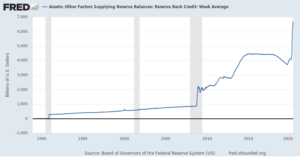Part one of a two-part series.
Amazon isn’t the only entity that will emerge from the COVID-19 pandemic stronger and more powerful than ever. The same can be said for the Federal Reserve Board, which is practically taking over the U.S. financial system.
The Fed’s control of the stock market is more evident than ever, but it will now also control much of the country’s lending.
The economic crisis that resulted from the pandemic required quick action, and the Fed provided it, taking advantage of new powers provided by the U.S. Congress in its Coronavirus Aid, Relief and Economic Security Act (CARES).
But is it advisable to put that much power into the hands of a government entity?
“The Fed is being sent on a mission to places it has never been before,” according to Adam Tooze, a Columbia University history professor. He believes Fed officials “are being sucked into a series of entanglements that they cannot control and that they normally will not touch with a long pole, but this time felt they had to go in, and go in hard.”
Economy Tanked, Stock Market Didn’t
Investors may be thankful, at least for now, that the Fed acted as a defibrillator, shocking the stock market back to life.
The Dow Jones Industrial Average dropped 28% in March, when the pandemic officially began, but regained much of its losses in April and May. The DJIA is still down 17.54% year to date as of this writing, but technically that’s not even bear market territory. The NASDAQ Composite Index, meanwhile, is pretty much even year to date.
In contrast, stock prices were chopped in half during the Great Recession, and it took four years for the market to recover. It took the stock market 25 years to recover from the Great Depression.
The market is volatile, but relatively calm considering that 36 million Americans have lost their jobs, which is more than twice the number of jobs lost during the Great Depression and nearly three times the number of jobs lost during the Great Recession. Thousands of businesses have been destroyed and more than 80,000 Americans have died from COVID-19.
And yet investors have emerged with barely a scratch to date. The DJIQ dropped 2.2% on May 13, but that was because Fed Chair Jerome Powell announced that further stimulus may be needed, beyond the nearly $3 trillion already allocated to fighting the pandemic and restoring the economy.
The stock market will likely continue to be volatile and could drop significantly when second-quarter earnings are announced, but the Fed will almost certainly continue to play a major role in the market’s performance.
The market’s rebound is largely due to the return of zero interest rate policy (ZIRP). As it did during the Great Recession, the Fed dropped interest rates to zero. When interest rates are low, stock prices typically increase, because yields on bonds are so low investors put more money into stocks.
ZIRP drove stock prices higher coming out of the Great Recession, even as the economy underperformed. ZIRP is boosting stock prices again.
The Fed’s Portfolio
To bring interest rates to zero, the Fed resumed its practice of buying billions of dollars’ worth of bonds every day (aka, quantitative easing). The Fed has never bought as many bonds as it is buying now.
Before the financial crisis, the Fed’s portfolio was less than $1 trillion. Buying bonds, it boosted its portfolio to about $4.5 trillion. As the economy strengthened, the Fed began to reduce its portfolio, whittling it down to about $3.8 trillion.
And yet the Fed’s portfolio has now swelled to more than $6.5 trillion and economists project that it will reach somewhere between $8 trillion and $11 trillion as a result of current programs.
With its asset purchases, “the Federal Reserve is stretching the boundaries for what a central bank will do to finance soaring federal debt — actions that move it deeper into political decisions it usually tries to avoid,” according to The Wall Street Journal.
When the Fed tried unwinding its $4.5 trillion portfolio in 2018, it was blamed for the end-of-year market meltdown. What will happen when it tries to unwind its $8 trillion (or more) portfolio? And will its actions be based on what’s best for the economy or what’s politically expedient?
